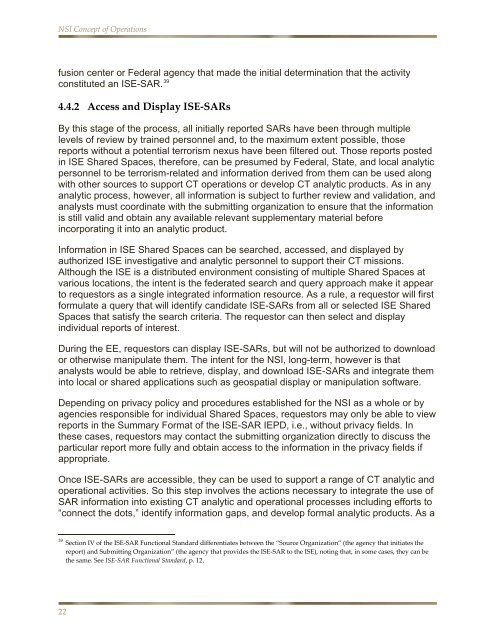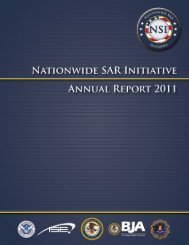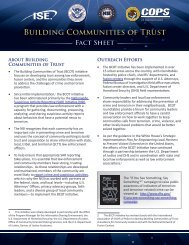NSI Concept of Operations Version 1, December 2008
NSI Concept of Operations Version 1, December 2008
NSI Concept of Operations Version 1, December 2008
Create successful ePaper yourself
Turn your PDF publications into a flip-book with our unique Google optimized e-Paper software.
<strong>NSI</strong> <strong>Concept</strong> <strong>of</strong> <strong>Operations</strong><br />
fusion center or Federal agency that made the initial determination that the activity<br />
constituted an ISE-SAR. 39<br />
4.4.2 Access and Display ISE‐SARs<br />
By this stage <strong>of</strong> the process, all initially reported SARs have been through multiple<br />
levels <strong>of</strong> review by trained personnel and, to the maximum extent possible, those<br />
reports without a potential terrorism nexus have been filtered out. Those reports posted<br />
in ISE Shared Spaces, therefore, can be presumed by Federal, State, and local analytic<br />
personnel to be terrorism-related and information derived from them can be used along<br />
with other sources to support CT operations or develop CT analytic products. As in any<br />
analytic process, however, all information is subject to further review and validation, and<br />
analysts must coordinate with the submitting organization to ensure that the information<br />
is still valid and obtain any available relevant supplementary material before<br />
incorporating it into an analytic product.<br />
Information in ISE Shared Spaces can be searched, accessed, and displayed by<br />
authorized ISE investigative and analytic personnel to support their CT missions.<br />
Although the ISE is a distributed environment consisting <strong>of</strong> multiple Shared Spaces at<br />
various locations, the intent is the federated search and query approach make it appear<br />
to requestors as a single integrated information resource. As a rule, a requestor will first<br />
formulate a query that will identify candidate ISE-SARs from all or selected ISE Shared<br />
Spaces that satisfy the search criteria. The requestor can then select and display<br />
individual reports <strong>of</strong> interest.<br />
During the EE, requestors can display ISE-SARs, but will not be authorized to download<br />
or otherwise manipulate them. The intent for the <strong>NSI</strong>, long-term, however is that<br />
analysts would be able to retrieve, display, and download ISE-SARs and integrate them<br />
into local or shared applications such as geospatial display or manipulation s<strong>of</strong>tware.<br />
Depending on privacy policy and procedures established for the <strong>NSI</strong> as a whole or by<br />
agencies responsible for individual Shared Spaces, requestors may only be able to view<br />
reports in the Summary Format <strong>of</strong> the ISE-SAR IEPD, i.e., without privacy fields. In<br />
these cases, requestors may contact the submitting organization directly to discuss the<br />
particular report more fully and obtain access to the information in the privacy fields if<br />
appropriate.<br />
Once ISE-SARs are accessible, they can be used to support a range <strong>of</strong> CT analytic and<br />
operational activities. So this step involves the actions necessary to integrate the use <strong>of</strong><br />
SAR information into existing CT analytic and operational processes including efforts to<br />
“connect the dots,” identify information gaps, and develop formal analytic products. As a<br />
39<br />
Section IV <strong>of</strong> the ISE‐SAR Functional Standard differentiates between the “Source Organization” (the agency that initiates the<br />
report) and Submitting Organization” (the agency that provides the ISE‐SAR to the ISE), noting that, in some cases, they can be<br />
the same. See ISE‐SAR Functional Standard, p. 12.<br />
22






